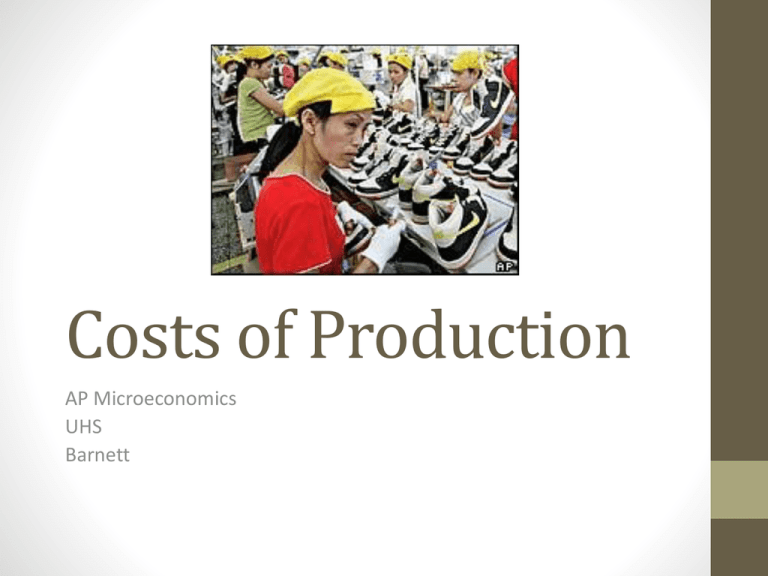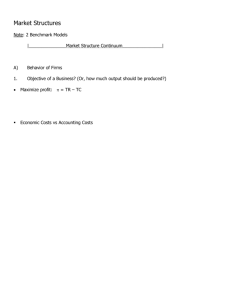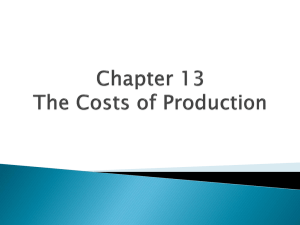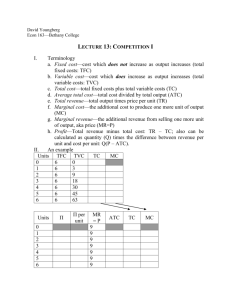
Costs of Production
AP Microeconomics
UHS
Barnett
Total Revenue, Total Cost,
Profit
• We assume that the firm’s goal is to maximize profit.
Profit = Total revenue – Total cost
the amount a
firm receives
from the sale
of its output
the market
value of the
inputs a firm
uses in
production
Costs: Explicit vs. Implicit
• Explicit costs require an outlay of money,
e.g., paying wages to workers.
• Implicit costs do not require a cash outlay,
e.g., the opportunity cost of the owner’s time.
• Remember one of the Ten Principles:
The cost of something is
what you give up to get it.
• This is true whether the costs are implicit or explicit. Both
matter for firms’ decisions.
Explicit vs. Implicit Costs: An Example
You need $100,000 to start your business.
The interest rate is 5%.
• Case 1: borrow $100,000
• explicit cost = $5000 interest on loan
• Case 2: use $40,000 of your savings,
borrow the other $60,000
• explicit cost = $3000 (5%) interest on the loan
• implicit cost = $2000 (5%) foregone interest you could have earned on
your $40,000.
In both cases, total (exp + imp) costs are $5000.
Economic Profit vs. Accounting Profit
• Accounting profit
= total revenue minus total explicit costs
• Economic profit
= total revenue minus total costs (including
explicit and implicit costs)
• Accounting profit ignores implicit costs,
so it’s higher than economic profit.
Using the information below, compute the explicit and implicit costs, the accounting
and economic profits. Then explain what will happen in this industry and why.
Total Revenue $600,000
Cost of materials $200,000
Wages to employees $250,000
Foregone wage $100,000
Foregone rent and interest $80,000
The explicit costs would be the out-of-pocket expenses of materials and employee
wages: 200,000 + 250,000 = $450,000.
The implicit costs are the foregone opportunities, $100,000 + $80,000 = $180,000.
The accounting profit is $150,000 computed by taking the total revenue $600,000 less
the explicit costs $450,000.
Subtracting the additional $180,000 of implicit costs leaves an economic profit of
negative $30,000.
Thus if this loss continues, we would anticipate the owner would exit this business.
ACTIVE LEARNING
2
Economic profit vs. accounting profit
The equilibrium rent on office space has just increased by
$500/month.
Determine the effects on accounting profit and economic profit if
a. you rent your office space
b. you own your office space
© 2012 Cengage Learning. All Rights Reserved. May not be copied, scanned, or duplicated, in whole or in part, except for use as
permitted in a license distributed with a certain product or service or otherwise on a password-protected website for classroom use.
ACTIVE LEARNING
Answers
2
The rent on office space increases $500/month.
a.You rent your office space.
Explicit costs increase $500/month.
Accounting profit & economic profit each fall $500/month.
b.You own your office space.
Explicit costs do not change,
so accounting profit does not change.
Implicit costs increase $500/month (opp. cost
of using your space instead of renting it),
so economic profit falls by $500/month.
© 2012 Cengage Learning. All Rights Reserved. May not be copied, scanned, or duplicated, in whole or in part, except for use as
permitted in a license distributed with a certain product or service or otherwise on a password-protected website for classroom use.
• Think about an airliner like Southwest Airlines. What are
their fixed costs and what are their variable costs in the
short run?
• Fixed – Insurance, depreciation of equipment (capital),
taxes, interest on loans, contract employees
• Variable – jet fuel, food (peanuts), wages to hourly
employees
Using the information below, compute the explicit and implicit costs, the accounting
and economic profits. Then explain what will happen in this industry and why.
Total Revenue $600,000
Cost of materials $200,000
Wages to employees $250,000
Foregone wage $100,000
Foregone rent and interest $80,000
The explicit costs would be the out-of-pocket expenses of materials and employee
wages: 200,000 + 250,000 = $450,000.
The implicit costs are the foregone opportunities, $100,000 + $80,000 = $180,000.
The accounting profit is $150,000 computed by taking the total revenue $600,000 less
the explicit costs $450,000.
Subtracting the additional $180,000 of implicit costs leaves an economic profit of
negative $30,000.
Thus if this loss continues, we would anticipate the owner would exit this business.
The Production Function
• A production function shows the relationship between the quantity
of inputs used to produce a good and the quantity of output of that
good.
• It can be represented by a table, equation, or graph.
• Example 1:
• Farmer Jack grows wheat.
• He has 5 acres of land.
• He can hire as many workers as he wants.
EXAMPLE 1: Farmer Jack’s Production Function
L
3,000
Q (bushels
(no. of
of wheat)
workers)
Quantity of output
2,500
0
0
1
1000
2
1800
3
2400
500
4
2800
0
5
3000
2,000
1,500
1,000
0
1
2
3
No. of workers
4
5
Marginal Product
• If Jack hires one more worker, his output rises by the marginal
product of labor.
• The marginal product of any input is the increase in output arising
from an additional unit of that input, holding all other inputs
constant.
• Notation:
∆ (delta) = “change in…”
Examples:
∆Q = change in output, ∆L = change in labor
• Marginal product of labor (MPL) =
∆Q
∆L
EXAMPLE 1: Total & Marginal Product
L
Q (bushels
(no. of
of wheat)
workers)
0
0
∆L = 1
1
∆L = 1
2
∆L = 1
∆L = 1
4
5
∆Q = 1000
1000
∆Q = 800
800
∆Q = 600
600
∆Q = 400
400
∆Q = 200
200
1000
1800
∆L = 1
3
MPL
2400
2800
3000
EXAMPLE 1: MPL = Slope of Prod Function
Q
(no. of (bushels
workers) of wheat)
0
MPL
0
1000
1
2
3
4
5
1000
1800
2400
2800
3000
MPL
3,000
800
600
400
200
Quantity of output
L
equals the
slope of the
2,500
production function.
2,000
Notice that
MPL diminishes
1,500
as L increases.
1,000
This explains why the
500
production
function
gets
flatter
0
as L increases.
0
1
2
3
4
No. of workers
5
Why MPL Is Important
• Recall one of the Ten Principles:
Rational people think at the margin.
• When Farmer Jack hires an extra worker,
• his costs rise by the wage he pays the worker
• his output rises by MPL
• Comparing them helps Jack decide whether he should
hire the worker.
Why MPL Diminishes
• Farmer Jack’s output rises by a smaller and smaller amount for each
additional worker. Why?
• As Jack adds workers, the average worker has less land to work with
and will be less productive.
• In general, MPL diminishes as L rises
whether the fixed input is land or capital (equipment, machines, etc.).
• Diminishing marginal product:
the marginal product of an input declines as the quantity of the input
increases (other things equa)
EXAMPLE 1: Farmer Jack’s Costs
• Farmer Jack must pay $1000 per month for the land,
regardless of how much wheat he grows.
• The market wage for a farm worker is $2000 per month.
• So Farmer Jack’s costs are related to how much wheat he
produces….
EXAMPLE 1: Farmer Jack’s Costs
L
Q
(no. of (bushels
workers) of wheat)
Cost of
land
Cost of
labor
Total
Cost
0
0
$1,000
$0
$1,000
1
1000
$1,000
$2,000
$3,000
2
1800
$1,000
$4,000
$5,000
3
2400
$1,000
$6,000
$7,000
4
2800
$1,000
$8,000
$9,000
5
3000
$1,000
$10,000
$11,000
EXAMPLE 1: Farmer Jack’s Total Cost Curve
$12,000
Total
Cost
0
$1,000
1000
$3,000
1800
$5,000
2400
$7,000
2800
$9,000
3000
$11,000
$10,000
Total cost
Q
(bushels
of wheat)
$8,000
$6,000
$4,000
$2,000
$0
0
1000
2000
3000
Quantity of wheat
Marginal Cost
• Marginal Cost (MC)
is the increase in Total Cost from
producing one more unit:
∆TC
MC =
∆Q
EXAMPLE 1: Total and Marginal Cost
Q
(bushels
of wheat)
0
Total
Cost
$1,000
∆Q = 1000
1000
$2.00
∆TC = $2000
$2.50
∆TC = $2000
$3.33
∆TC = $2000
$5.00
∆TC = $2000
$10.00
$5,000
∆Q = 600
2400
$7,000
2800
$9,000
3000
$11,000
∆Q = 400
∆Q = 200
∆TC = $2000
$3,000
∆Q = 800
1800
Marginal
Cost (MC)
EXAMPLE 1: The Marginal Cost Curve
0
TC
MC
$1,000
$2.00
1000
$3,000
$2.50
1800
$5,000
$3.33
2400
$7,000
2800
$9,000
3000
$11,000
$10
Marginal Cost ($)
Q
(bushels
of wheat)
$12
$8
MC usually rises
as Q rises,
as in this example.
$6
$4
$2
$5.00
$10.00
$0
0
1,000
2,000
Q
3,000
Why MC Is Important
• Farmer Jack is rational and wants to maximize
his profit. To increase profit, should he produce
more or less wheat?
• To find the answer, Farmer Jack needs to
“think at the margin.”
• If the cost of additional wheat (MC) is less than
the revenue he would get from selling it,
then Jack’s profits rise if he produces more.
Fixed and Variable Costs
• Fixed costs (FC) do not vary with the quantity of
output produced.
• For Farmer Jack, FC = $1000 for his land
• Other examples:
cost of equipment, loan payments, rent
• Variable costs (VC) vary with the quantity
produced.
• For Farmer Jack, VC = wages he pays workers
• Other example: cost of materials
• Total cost (TC) = FC + VC
EXAMPLE 2
• Our second example is more general,
applies to any type of firm
producing any good with any types of inputs.
EXAMPLE 2: Costs
Q
FC
$100
1
TC
FC
$700
VC
TC
$0 $100
$600
100
70
170
$500
2
100
120
220
3
100
160
260
4
100
210
310
5
100
280
380
6
100
380
480
7
100
520
620
Costs
0
VC
$800
$400
$300
$200
$100
$0
0
1
2
3
4
Q
5
6
7
EXAMPLE 2: Marginal Cost
TC
0 $100
1
170
2
220
3
260
4
310
5
380
6
480
7
620
MC
$70
50
40
50
70
100
140
$200 Marginal Cost (MC)
Recall,
$175change in total cost from
is the
producing
one more unit:
$150
∆TC
MC =
∆Q
$100
Usually,
MC rises as Q rises, due to
$75
diminishing marginal product.
Costs
Q
$125
$50
Sometimes (as here), MC falls before
$25
rising.
$0
(In other0examples,
MC 4may5be 6
1 2 3
constant.)
Q
7
EXAMPLE 2: Average Fixed Cost
FC
0 $100
AFC
n/a
1
100
$100
2
100
50
3
100
33.33
4
100
25
5
100
20
6
100
16.67
7
100
14.29
$200
Average
fixed cost (AFC)
is$175
fixed cost divided by the
quantity
of output:
$150
Costs
Q
AFC = FC/Q
$125
$100
Notice
$75 that AFC falls as Q rises: The
firm is spreading its fixed costs over
$50
a larger and larger number of units.
$25
$0
0
1
2
3
4
Q
5
6
7
EXAMPLE 2: Average Variable Cost
VC
AVC
0
$0
n/a
1
70
$70
2
120
60
3
160
53.33
4
210
52.50
5
280
56.00
6
380
63.33
7
520
74.29
$200
Average
variable cost (AVC)
is$175
variable cost divided by the
quantity of output:
$150
Costs
Q
AVC = VC/Q
$125
$100
As$75
Q rises, AVC may fall initially. In
most cases, AVC will eventually rise
$50
as output rises.
$25
$0
0
1
2
3
4
Q
5
6
7
EXAMPLE 2: Average Total Cost
Q
TC
0 $100
ATC
AFC
AVC
n/a
n/a
n/a
1
170
$170
$100
$70
2
220
110
50
60
3
260
86.67
33.33
53.33
4
310
77.50
25
52.50
5
380
76
20
56.00
6
480
80
16.67
63.33
7
620
88.57
14.29
74.29
Average total cost
(ATC) equals total cost
divided by the quantity
of output:
ATC = TC/Q
Also,
ATC = AFC + AVC
EXAMPLE 2: Average Total Cost
TC
0 $100
1
2
170
220
ATC
$200
Usually,
as in this example, the
$175
ATC curve is U-shaped.
n/a
$150
$170
110
$125
Costs
Q
$100
3
260
86.67
4
310
77.50
5
380
76
$25
6
480
80
$0
7
620
88.57
$75
$50
0
1
2
3
4
Q
5
6
7
EXAMPLE 2: The Various Cost Curves Together
$200
$175
$150
$125
Costs
ATC
AVC
AFC
MC
$100
$75
$50
$25
$0
0
1
2
3
4
Q
5
6
7
ACTIVE LEARNING
Calculating costs
3
Fill in the blank spaces of this table.
Q
VC
0
1
10
2
30
TC
AFC
AVC
ATC
$50
n/a
n/a
n/a
$10
$60.00
80
3
16.67
4
100
5
150
6
210
150
20
12.50
36.67
8.33
$10
30
37.50
30
260
MC
35
© 2012 Cengage Learning. All Rights Reserved. May not be copied, scanned, or duplicated, in whole or in part, except for use as
permitted in a license distributed with a certain product or service or otherwise on a password-protected website for classroom use.
43.33
60
ACTIVE LEARNING
Answers
3
Use
AFC
FC/Q
ATC
AVC
== TC/Q
VC/Q
First,relationship
deduce
FC =between
$50 andMC
useand
FC +TC
VC = TC.
Q
VC
TC
AFC
AVC
ATC
0
$0
$50
n/a
n/a
n/a
1
10
60
$50.00
$10
$60.00
2
30
80
25.00
15
40.00
3
60
110
16.67
20
36.67
4
100
150
12.50
25
37.50
5
150
200
10.00
30
40.00
6
210
260
8.33
35
43.33
© 2012 Cengage Learning. All Rights Reserved. May not be copied, scanned, or duplicated, in whole or in part, except for use as
permitted in a license distributed with a certain product or service or otherwise on a password-protected website for classroom use.
MC
$10
20
30
40
50
60
EXAMPLE 2: The Various Cost Curves Together
$200
$175
$150
$125
Costs
ATC
AVC
AFC
MC
$100
$75
$50
$25
$0
0
1
2
3
4
Q
5
6
7
EXAMPLE 2: Why ATC Is Usually U-Shaped
As Q rises:
$200
Initially,
falling AFC
pulls ATC down.
$175
Efficient scale:
The quantity that
minimizes ATC.
$125
Costs
Eventually,
rising AVC
pulls ATC up.
$150
$100
$75
$50
$25
$0
0
1
2
3
4
Q
5
6
7
EXAMPLE 2: ATC and MC
When MC < ATC,
ATC is falling.
$175
$150
ATC is rising.
$125
Costs
When MC > ATC,
The MC curve
crosses the
ATC curve at
the ATC curve’s
minimum.
ATC
MC
$200
$100
$75
$50
$25
$0
0
1
2
3
4
Q
5
6
7
Total Cost = ATC*Q = $15*10 = $150
Total Variable Cost = AVC*Q = $8*10 = $80
The vertical distance between ATC and AVC is AFC, so TFC = AFC*Q = $7*10 = $70
If the total fixed cost is $70 then at 20 units of output, the vertical distance
between ATC and AVC which is the AFC would be $3.50.
Similar mirror-image relationship between AP & AVC
Costs in the Short Run & Long
Run
• Short run:
Some inputs are fixed (e.g., factories, land).
The costs of these inputs are FC.
• Long run:
All inputs are variable
(e.g., firms can build more factories,
or sell existing ones).
• In the long run, ATC at any Q is cost per unit using the most
efficient mix of inputs for that Q (e.g., the factory size with the
lowest ATC).
EXAMPLE 3: LRATC with 3 factory sizes
Firm can choose
from three factory
sizes: S, M, L.
Each size has its own
SRATC curve.
The firm can change
to a different factory
size in the long run,
but not in the short
run.
Avg
Total
Cost
ATCS
ATCM
ATCL
Q
EXAMPLE 3: LRATC with 3 factory sizes
To produce less than
QA, firm will choose Avg
Total
size S
Cost
in the long run.
To produce between
QA
and QB, firm will
choose size M
in the long run.
To produce more
than QB, firm will
choose size L
in the long run.
ATCS
ATCM
ATCL
LRATC
QA
QB
Q
Long run average cost curve
(LRATC) shows the minimum
average cost of producing any
given level of output
A Typical LRATC Curve
In the real world,
factories come in
many sizes,
each with its own
SRATC curve.
ATC
LRATC
So a typical LRATC
curve
looks like this:
Different industries
have different
shaped LRATC’s
Q
How ATC Changes as
the Scale of Production Changes
Economies of scale:
ATC falls
as Q increases.
ATC
LRATC
Constant returns to
scale: ATC stays the
same
as Q increases.
Diseconomies of
scale: ATC rises
as Q increases.
Q
The AC curve is broken into three areas
Increasing Returns to Scale (economies of scale) - For instance doubling
the inputs leads to a more than doubling of output
Constant Returns to Scale - Doubling of inputs leads to a doubling of
output
Decreasing Returns to Scale (diseconomies of scale) - Doubling of inputs
leads to less than doubling of output.
How ATC Changes as
the Scale of Production Changes
• Economies of scale occur when increasing production allows greater
specialization:
workers more efficient when focusing on a narrow task.
•
•
•
•
•
•
More common when Q is low.
Spreading out of design and development costs (Movie Industry)
Purchasing inputs in bulk – lower per unit cost (railway industry)
more intensive use of highly skilled personnel
more intensive use of capital (for instance, with shifts)
ability to utilize by-products rather than discard them.
How ATC Changes as
the Scale of Production Changes
• Diseconomies of scale are due to coordination problems in large
organizations.
E.g., management becomes stretched, can’t control costs.
• More common when Q is high.
• - difficulties in control and supervision,
- slow decision making due to excessive size of administration,
- lack of employee motivation.
The minimum efficient scale:
is the smallest output that a plant (or firm) can produce
such that its long run average costs are minimized.
Beyond this level of production, as this firm continues to
grow, it will see no further cost benefits
The minimum efficient scale:
is smallest output that a plant (or firm) can
produce such that its long run average costs are
minimized.
Beyond this level of production, as this firm
continues to grow, it will see no further cost
benefits
Difference between short-run ATC & LRATC curves
Economies of Scope: Lower the per unit cost as the range of products
produced increases
Discussion Questions:
1. What does it mean that a firm can become “too big for its own good”?
Can you think of any other organizations (economic or otherwise) that have
gotten so big that they’ve failed?
2. Why does your hometown have only one electricity company? Why
aren’t utility industries such as water, natural gas, and garbage collection
more competitive? How does the concept of economies of scale lead to
certain industries being “natural monopolies”?
3. Why don’t more companies make jumbo jets?
SUMMARY
• Implicit costs do not involve a cash outlay,
•
•
yet are just as important as explicit costs
to firms’ decisions.
Accounting profit is revenue minus explicit costs. Economic profit is
revenue minus total (explicit + implicit) costs.
The production function shows the relationship between output
and inputs.
© 2012 Cengage Learning. All Rights Reserved. May not be copied, scanned, or duplicated, in whole or in part, except for use as
permitted in a license distributed with a certain product or service or otherwise on a password-protected website for classroom use.
SUMMARY
• The marginal product of labor is the increase in output from a one•
•
unit increase in labor, holding other inputs constant. The marginal
products of other inputs are defined similarly.
Marginal product usually diminishes as the input increases. Thus,
as output rises, the production function becomes flatter, and the
total cost curve becomes steeper.
Variable costs vary with output; fixed costs do not.
© 2012 Cengage Learning. All Rights Reserved. May not be copied, scanned, or duplicated, in whole or in part, except for use as
permitted in a license distributed with a certain product or service or otherwise on a password-protected website for classroom use.
SUMMARY
• Marginal cost is the increase in total cost from an extra unit of
•
•
•
production. The MC curve is usually upward-sloping.
Average variable cost is variable cost divided by output.
Average fixed cost is fixed cost divided by output. AFC always falls
as output increases.
Average total cost (sometimes called “cost per unit”) is total cost
divided by the quantity of output. The ATC curve is usually Ushaped.
© 2012 Cengage Learning. All Rights Reserved. May not be copied, scanned, or duplicated, in whole or in part, except for use as
permitted in a license distributed with a certain product or service or otherwise on a password-protected website for classroom use.
SUMMARY
• The MC curve intersects the ATC curve
•
•
at minimum average total cost.
When MC < ATC, ATC falls as Q rises.
When MC > ATC, ATC rises as Q rises.
In the long run, all costs are variable.
Economies of scale: ATC falls as Q rises. Diseconomies of scale:
ATC rises as Q rises. Constant returns to scale: ATC remains
constant as Q rises.
© 2012 Cengage Learning. All Rights Reserved. May not be copied, scanned, or duplicated, in whole or in part, except for use as
permitted in a license distributed with a certain product or service or otherwise on a password-protected website for classroom use.







